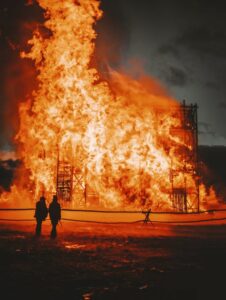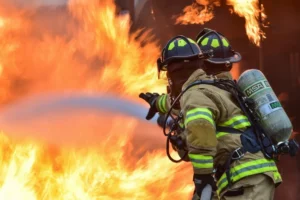How to claim bush/lalang destroy your home
It’s been scorched and hazy in most parts of the country. Here is a “simple write-up” about standard fire insurance policy coverage for losses caused by bush (or lalang) fire damage to your home. How to claim bush/lalang destroys your home?
Bush fires can erupt at any time. When a bush fire approaching your home and family, it’s critical to assess your risks and prepare.
Making a bush fire plan is one of the most important things.
You are prioritized to know if you have fire insurance or house insurance.
A policy for bush/lalang fire insurance
How to claim bush/lalang destroy your home
If you have or are about to buy a fire insurance policy to protect your home, please turn to the page with condition 8. This section on exclusions focuses explicitly on 8(i): 8. Unless the policy says otherwise, this insurance does not cover: In this case, the fires that burn forests, grasslands, prairies, and jungle can cause a lot of damage, but they can cost you a lot of money.
Fire loss or damage to property f due to forest, jungle, bush, or other forests, jungle, or no cover for bush fire spreading by the wording in 8 I. If a fire of this kind spread and damaged your home, there would be no way to stop it.
In this case, BUSH and LALANG fired.
The rate is: 0.005%
Wording of Endorsement
Conditions 8(i) of this policy say they don’t cover fires caused by bush/lalang. The Company agrees to pay an extra premium to cover fires caused by bush/lalang, but only if the Insured keeps their land free from lalang and undergrowth while this policy is in effect.
In other words, unless there are different rules and regulations in the policy.
However, suppose you choose a more comprehensive policy, such as a Householders or Homeowners Insurance policy. There is no exclusion for losses to insured property caused by bush or lalang fires – even subterranean fires are covered.

How to claim bush/lalang destroy your home
IN A BUSH/lalang FIRE-PRONE AREA, HOW DO I PREPARE?
Don’t wait until the damage occurs to gather insurance information and images and videos of your property and goods. Save this information and evidence safely somewhere you can reach it readily if you need to flee.
Taking video or images before a bush fire can help you and the insurance provider process your claim more swiftly.
Call to make sure you have appropriate coverage in case of a bush fire. Will your house building insurance cover a rebuild? Consider a policy with a “safety net” amount if building expenses rise due to increased demand for materials or new building requirements.
Remember that many insurances exclude coverage for bush/lalang fire damage if purchased within 30 days of the event. Many plans do not allow claims for wildfire damage within 72 hours of purchase, although some only allow claims within 48 hours.
How to claim bush/lalang destroy your home
Are you insured for bush/lalang fire ?
Do you have insurance to recoup damages and losses caused by bush fires?.
The most common policies are:
Home Building Insurance covers building demolition or damage.
Personal and household goods
Motor Vehicle Insurance covers cars, motorcycles, trailers, and caravans.
RECLAMATION
The initial step is to notify your insurers of your claim. Unsure if your claim is covered? File a claim and see what the insurance responds.
Note: If your policy documentation is lost or destroyed, don’t worry; insurance companies store records electronically and need the policyholder’s name and address to handle claims. Your insurer must send you a copy and may have them online.
How to claim bush/lalang destroy your home

IMPORTANT: Are you covered for temporary housing fees.
Additional policy benefits explain this in more detail.
The insurance company will send an adjuster to inspect the damage and gather information to determine coverage. This process may take time during natural disasters like bushfires.
Always remember that your safety comes first. Only enter damaged buildings if safe. Always follow emergency service directions.
Next, you must safeguard your possessions. you take reasonable precautions to prevent further damage. Suppose you can protect your property from other loss, such as tarping exposed items or placing it undercover. The document includes images, receipts, and council or local emergency service directives.
Take photos of damaged things and buildings to help you keep track of your losses.
Document everything and try to gain the insurer’s authorization before disposing of anything because it is a safety issue.
You should be aware of your insurer’s entitlement to inspect your property and decide who should repair/rebuild/replace what. Before beginning any work, you should consult with your insurer.
How to claim bush/lalang destroy your home
Note: An insurer may want you to make a room-by-room inventory of damaged property. If you lose everything, ask them to pay your entire insurance amount. If they insist on a listing, ask why and seek guidance.
May determine a person to be accountable for igniting the fire. While your insurance may not cover your entire loss, you may wish to gather documentation of a court case, investigation or open another source of compensation.
The sorts of risks or insured events covered by insurance plans differ from Policy to Policy, as do the occurrences or losses excluded. Ensure you read your policy and understand your coverage to obtain your benefits.you may not get all your losses paid.
Many insurance packages cover bush fires/lalang destroy to your home. However, what is covered and in what circumstances may be limited.
Common flaws include:
Bush fires that occur during the first 48 or 72 hours after purchasing the policy are usually not covered e.g., you just leased the property or changed policies from another insurer without lapsing and for the same cover.
No flame or burning building within 10 yards of your home means no scorching, burn marks, or melting damage.
until your buildings or stuff have caught fire
The policy’s terms determine the extent of your cover.
Many policies also require you to take precautions to avoid loss, such as sweeping gutters to lessen the danger of embers carried by the wind setting fire in the leaves. No need to endanger your health or safety or break local planning restrictions. What is reasonable can be disputed, especially if the fire was unexpectedly severe.
REPAIR/REPLACEMENT OR CASH
Often, the insurer has the right to decide whether to repair, replace, or payout. You can try to negotiate when they ask how you want to settle.
Accepting a cash settlement offer requires extreme caution. In your negotiations, keep in mind:
If an insurer decides to repair or rebuild, they are responsible. Insurers guarantee their work. They also manage the sometimes tricky repair process. Sometimes the repair costs are unknown so it is best to agree for a cash settlement and hire your repairer, you will be responsible for any issues arising from the repair quality.
Get your quotes to ensure the amount offered is reasonable. Repair/rebuild/replacement quotes obtained by the insurance company may not be accurate. Before settling on a final amount, you must carefully consider this sum.
You may receive store credit instead of cash if your policy allows it. If the policy does not allow store credit, you can request some money instead. However, the insurer may reduce your cash settlement below the stated value of the store credit. As policies vary, seek advice.
Determine whether you’re settling the entire claim or just a portion of it. You may have “Additional Benefits” on your building and contents insurance. Make sure you know what your policy covers.
BENEFITS OF YOUR POLICY
Your home building and contents policy may cover additional costs such as emergency/alternative housing, debris removal and demolition, architects, surveyors, and legal fees.
Can add these benefits to your insurance coverage. So, before accepting any claim settlement, make sure you are entitled to more than your sum insured due to additional benefits cover.
ACCOMMODATION IN EMERGENCY
If you can no longer live in your home, contact your insurer to see if you have temporary housing entitlements and for how long.
A clause to note whether covers you for temporary housing is:
the insurer will pay for comparable housing for up to 12 months while your building is rebuilt or repaired.”
POLICY CHECKLIST
Insurance policies for temporary/emergency housing vary. Examples:
Exact percentage (e.g., 10%) of the policy value that your insurer will cover you for temporary/emergency accommodation;
Assuming your insurer will cover “reasonable costs.”
Limitations on time: Some policies limit the amount of time you can claim for emergency lodging.
Warning: Your insurer may put you in an expensive temporary property that quickly depletes your accommodation allowance. If rebuilding your home will take 12 months, you will need a long-term housing solution.
DEBRIS DEMOLITION
Debris removal and land clearing can be expensive.
Check what types of “debris” are covered. For example, the policy may not cover trees, shrubs, and plant debris.
For example, your policy may cover “Removing buildings and contents debris from your risk address.”
Although not listed as “buildings or their contents,” trees and plants are not listed as “buildings.”
If you need help reading a policy, please contact your agent or the insurer.

LEGAL FEES, ARCHITECTURAL FEES
Most home building insurance policies cover the costs of architects, surveyors, and legal fees associated with rebuilding or repairing damaged buildings.
If you’re not sure, look for a clause in your policy that says something like this:
“We will pay for a reasonable architect, surveyor, and legal fees. Ten percent of your building’s insured value.”
COSTS OF NEW REGULATIONS
Events such as bush fires, local governments often introduce new regulations and fire safety standards; the authority may have implemented new rules since you built your home.
Do your policy cover these costs? A clause to watch out for is:
It includes “any additional costs required to comply with government or local authority by-laws.”
Will likely cover additional Additional compliance costs if your policy replaces your property “like new” or “total replacement cover.”
DIRE FINANCIAL NEED
If you need cash urgently, your insurer must expedite your claim and make an advance payment within five business days. The insurer may deducted any advance payment from your claim total.
If a bush fire affects your family, you can request the government for an emergency aids. Contact your bank immediately to help you if you have a house loan.
I would welcome any constructive comments in the box below.
